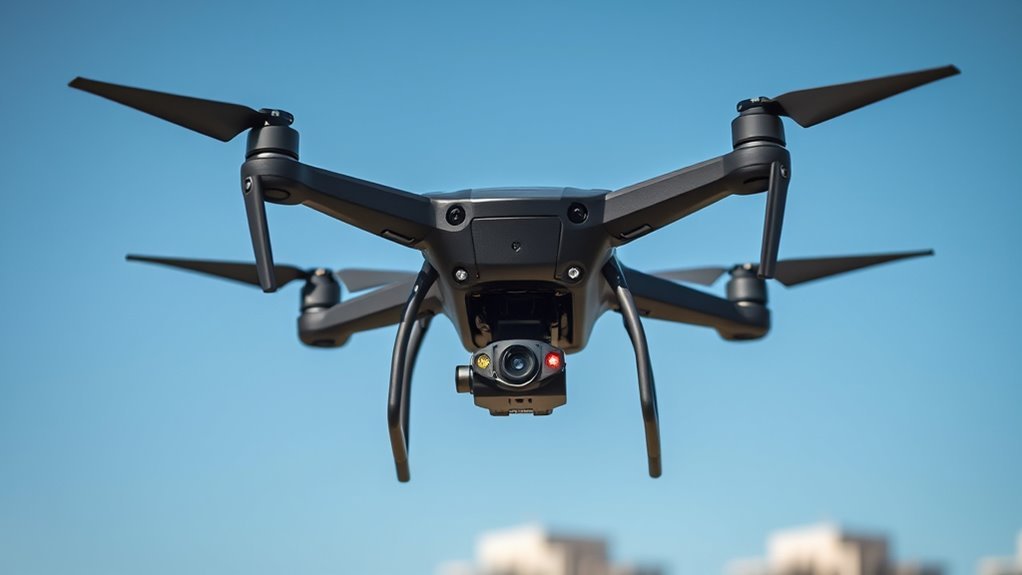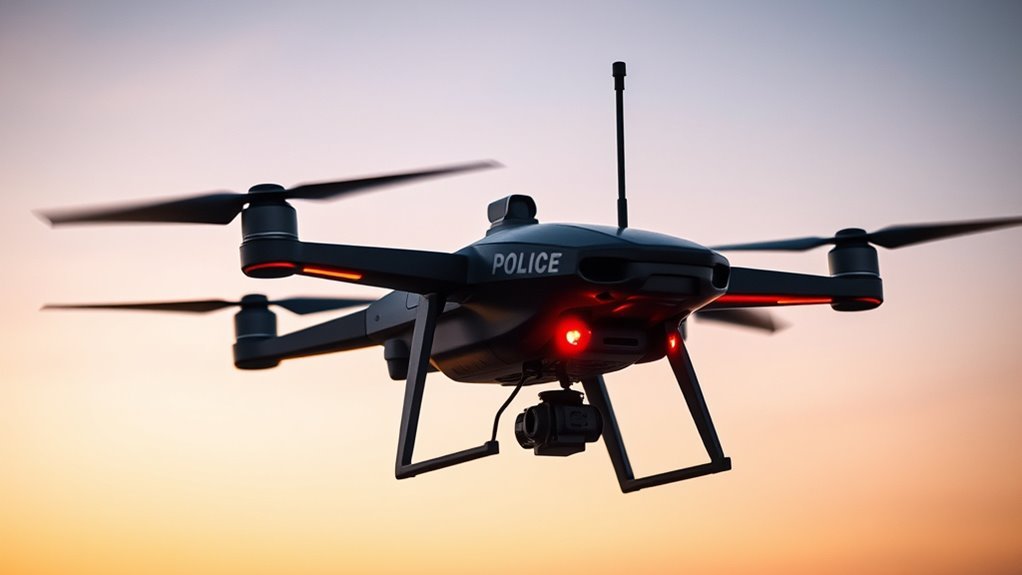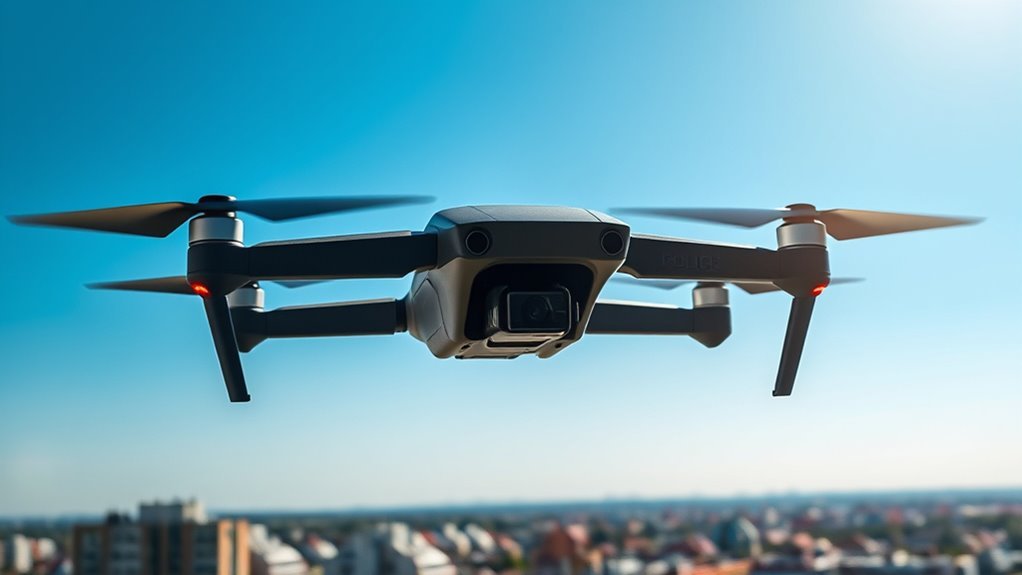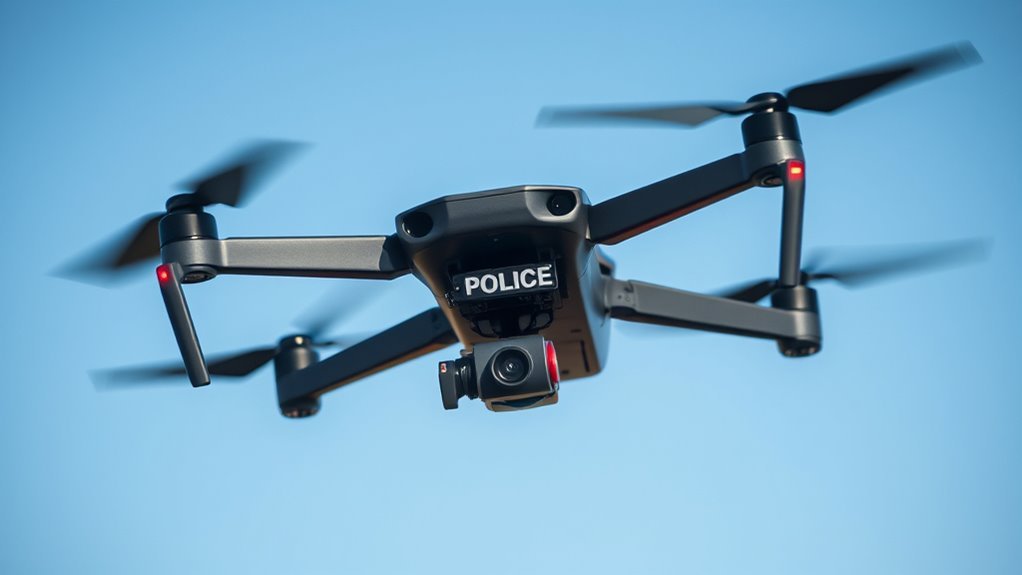Police drones typically sport aerodynamic body shapes for stability and flight efficiency. You’ll notice advanced thermal imaging for nighttime operations, high-resolution cameras, and specialized sensors optimized for real-time surveillance. Their designs often include visible markings for easy identification, while durable materials like carbon fiber enhance their robustness. Equipped with secure communication systems, these drones excel in crowd control and other operations. There’s much more to explore about their capabilities and applications in law enforcement.
Overview of Police Drones

As law enforcement agencies increasingly embrace technology, police drones have emerged as an essential tool for enhancing operational efficiency and situational awareness. These unmanned aerial vehicles provide real-time aerial surveillance, enabling officers to assess complex situations from a safe distance. However, the deployment of drones isn’t without challenges, particularly concerning drone regulations that govern their use. Ensuring compliance with local laws is fundamental to maintain transparency and public trust. Public perception of police drones varies; while some view them as critical for community safety, others express concerns about privacy invasion. By maneuvering through these regulatory frameworks and addressing public sentiment, law enforcement can effectively utilize drone technology while respecting citizens’ freedoms and rights. Additionally, real-time aerial surveillance capabilities enable rapid hazard identification and enhance safety for first responders during critical incidents. The integration of advanced AI in drone operations ensures that these devices can adapt to evolving threats and provide actionable intelligence.
Distinctive Design Elements

When examining police drones, you’ll notice distinctive design elements that enhance their functionality. Body shape variations play an essential role in aerodynamics and stability, while the strategic placement of cameras and sensors maximizes surveillance capabilities. Additionally, color and markings not only aid in identification but also contribute to operational effectiveness during missions. Many police drones also incorporate advanced camera capabilities that allow for high-quality visual content, even in challenging lighting conditions.
Body Shape Variations
Although police drones primarily serve the same functional purpose of surveillance and reconnaissance, their body shape variations introduce distinctive design elements that can markedly impact performance and maneuverability. Aerodynamic designs optimize flight efficiency, allowing drones to navigate urban environments with ease. These designs often feature streamlined bodies that reduce drag, enhancing speed and stability during operations.
Additionally, drone dimensions play a critical role; smaller models are more agile, making them ideal for tight spaces, while larger drones can carry more advanced equipment but may sacrifice maneuverability. Understanding these body shape variations helps you appreciate how each model is tailored to specific operational needs, ultimately supporting the freedom of movement and effectiveness in law enforcement activities.
Camera and Sensor Placement
Body shape variations and their aerodynamic properties naturally influence the placement of cameras and sensors on police drones. Typically, you’ll find high-resolution camera technology mounted on a gimbal for stability, often positioned at the front for ideal forward visibility. This allows for real-time video feeds essential in surveillance operations. Sensor types, such as thermal and multispectral, are strategically placed to maximize coverage and minimize obstructions. These sensors enhance the drone’s capability to detect heat signatures or analyze environmental data, vital for search and rescue missions. The integration of these elements requires careful consideration of weight distribution and airflow, ensuring the drone remains agile while effectively capturing critical information. Each design aspect aims for efficiency and operational effectiveness in the field.
Color and Markings
The color and markings on police drones play a crucial role in their identification and operational effectiveness. You’ll notice that these drones often feature specific color schemes designed to enhance visibility while maintaining a professional appearance. Common colors include matte black, gray, and bright hues like neon yellow or orange, which serve to distinguish them from civilian drones. Marking patterns, such as department insignias or reflective stripes, are strategically placed to guarantee easy recognition during missions. These design elements not only promote accountability but also foster public awareness regarding drone operations. By understanding these characteristics, you can appreciate how they contribute to the balance between law enforcement visibility and community trust, embodying a commitment to transparency in policing practices.
Advanced Thermal Imaging Capabilities

Advanced thermal imaging capabilities in police drones greatly enhance operational efficiency during nighttime operations. You’ll find that these systems excel at heat signature detection, allowing for precise identification of individuals or objects in low-visibility conditions. This technology not only improves situational awareness but also aids in effective decision-making in critical scenarios.
Enhanced Night Vision
While traditional surveillance methods often struggle in low-light conditions, police drones equipped with enhanced night vision capabilities greatly improve operational effectiveness. These drones utilize advanced night vision technology, allowing them to capture clear images even in complete darkness. By integrating infrared capabilities, they can detect heat signatures emitted by individuals and objects, providing critical data for law enforcement without compromising public safety. This technology not only enhances situational awareness but also enables proactive responses in emergencies. With the ability to cover vast areas quickly, these drones empower officers to maintain freedom and security within communities. Ultimately, enhanced night vision serves as an essential tool, facilitating effective and efficient policing under challenging circumstances.
Heat Signature Detection
Equipped with advanced thermal imaging capabilities, police drones can detect heat signatures, providing invaluable insights during surveillance operations. Utilizing sophisticated infrared sensors, these drones excel in thermal detection, identifying warm bodies or objects even in complete darkness. This technology allows you to monitor large areas efficiently, pinpointing potential threats or missing persons without alerting them to your presence. The drones can differentiate between various heat sources, allowing for tactical decision-making in real-time. By interpreting thermal data accurately, law enforcement can respond more effectively to situations, enhancing public safety while respecting individual rights. This balance of technology and civil liberties demonstrates how thermal imaging can empower your community without infringing on freedom.
Enhanced Flight Stability and Range
As police forces increasingly rely on drones for surveillance and operational support, enhanced flight stability and range have become critical factors in their effectiveness. Optimizing flight performance not only improves operational efficiency but also guarantees reliable data collection during missions. Here are three key aspects that contribute to enhanced flight stability and range:
- Advanced GPS Technology: Precise positioning systems allow for accurate navigation, minimizing drift. Additionally, advanced stabilization features ensure that footage remains sharp and clear, even during challenging conditions.
- Dynamic Flight Control Systems: These systems adapt in real-time to wind and weather conditions, maintaining stability.
- Extended Battery Life: Increased power capacity enables longer flight durations, enhancing overall mission scope. Additionally, drones like the Draganfly Vital Intelligence can achieve up to 25 minutes of flight time per charge, further extending operational capabilities.
Durable Construction Materials
Since police drones are often deployed in demanding environments, the choice of durable construction materials is essential for guaranteeing their longevity and reliability. When it comes to material selection, manufacturers typically prioritize lightweight yet robust composites, such as carbon fiber and reinforced plastics. These materials undergo rigorous durability testing to withstand impacts, extreme temperatures, and moisture exposure. You’ll find that high-quality drones incorporate aluminum alloys for structural components, providing a balance of strength and weight. Additionally, protective coatings are applied to resist corrosion and wear. This commitment to durability guarantees that your drone can perform effectively in diverse conditions, maintaining operational integrity when it matters most. Choosing the right materials is fundamental for mission success and enhancing public safety. Furthermore, many security drones, like the Draganfly Commander, feature modular construction that allows for easier repairs and adaptability in changing operational environments. Coretronics cameras, known for their precision engineering, enhance the capabilities of drones by providing high-resolution imaging that is crucial for effective surveillance and data capture.
Integrated Communication Systems
While effective communication is essential for law enforcement operations, integrated communication systems within police drones enhance situational awareness and coordination. These systems utilize advanced communication protocols and diverse connectivity options to guarantee real-time data exchange. When evaluating their capabilities, consider the following:
- Secure Data Transmission: Utilizing encryption to safeguard sensitive information during operations. This ensures that the data exchanged remains confidential and protected from potential threats, similar to the secure communication links used in advanced drone systems.
- Multi-Channel Communication: Allowing simultaneous voice and video feeds, ensuring all units stay informed and responsive.
- Interoperability: Facilitating seamless communication across various platforms and agencies, fostering collaboration in critical situations. Additionally, these systems can leverage AI-driven solutions to improve operational efficiency and enhance overall effectiveness in the field.
Specialized Equipment for Surveillance
Effective surveillance is vital for modern policing, and police drones are equipped with specialized equipment that enhances their observational capabilities. These drones often feature high-resolution cameras and infrared sensors, enabling detailed aerial surveillance under various conditions. You’ll find that some models include advanced zoom functionalities for capturing specific details from great distances. Additionally, real-time data transmission allows for immediate analysis and decision-making. However, while these technological advancements improve efficiency, they also raise significant privacy concerns. The balance between effective law enforcement and individual rights is imperative. It’s important to engage in discussions about regulations governing drone usage to guarantee transparency and protect civil liberties while utilizing these powerful tools for public safety. Moreover, many police drones now incorporate advanced stabilization features, ensuring that footage remains clear even in challenging environments.
Applications in Crowd Control
As public gatherings become more common, the use of police drones for crowd control has emerged as a pivotal strategy in maintaining safety and order. These drones enhance public safety by actively monitoring crowd dynamics and allowing for rapid response to incidents. Here are three key applications:
- Real-Time Surveillance: Drones provide aerial views, helping law enforcement assess crowd behavior and identify potential disturbances before they escalate.
- Communication Support: Equipped with loudspeakers, drones can relay instructions or warnings to the crowd, fostering compliance and reducing panic.
- Data Collection: Drones can gather analytics on crowd density and movement patterns, aiding in future event planning and security measures.
Incorporating these technologies empowers authorities while respecting individual freedoms, ensuring an effective balance between safety and civil liberties.
Role in Search and Rescue Operations
When emergencies arise in remote or difficult-to-access areas, police drones play an essential role in enhancing search and rescue operations. Equipped with thermal imaging and high-resolution cameras, they provide real-time data that markedly improves search techniques. You can quickly identify heat signatures from missing persons or locate stranded individuals, especially in adverse weather conditions. Drones also facilitate efficient rescue coordination by mapping the terrain and relaying vital information to ground teams. This aerial perspective allows for an extensive understanding of the situation, enabling faster decision-making. By integrating drones into rescue efforts, responders can maximize their effectiveness and guarantee that every second counts in saving lives. Ultimately, these advancements empower communities to act swiftly in emergencies, fostering a sense of security and freedom.
Frequently Asked Questions
How Are Police Drones Operated During Missions?
During a search and rescue mission, you’d utilize drone operation protocols to navigate terrain. By following mission protocols, you guarantee effective data collection and real-time communication, enhancing safety and success in critical situations.
What Is the Average Lifespan of a Police Drone?
The average lifespan of a police drone typically ranges from three to five years, depending on factors like drone technology advancements, usage intensity, and maintenance practices. Regular upkeep can considerably enhance longevity and operational efficiency.
Are There Regulations for Police Drone Usage?
Are there rules governing police drones? Absolutely! Police drone regulations stipulate strict drone usage guidelines, ensuring privacy, safety, and accountability. Balancing law enforcement needs with citizens’ freedoms creates a framework for responsible drone operations.
How Do Police Drones Differ From Commercial Drones?
Police drones differ from commercial drones primarily in their specialized police drone technology tailored for law enforcement applications, featuring advanced surveillance capabilities, enhanced durability, and often integrated systems for real-time data collection and analysis, ensuring operational efficiency and safety.
What Are the Privacy Concerns Regarding Police Drone Surveillance?
You should consider the surveillance ethics surrounding police drones. They raise significant privacy concerns, particularly regarding data security. Unchecked use can infringe on individual freedoms, leading to potential misuse of collected information in public spaces.

